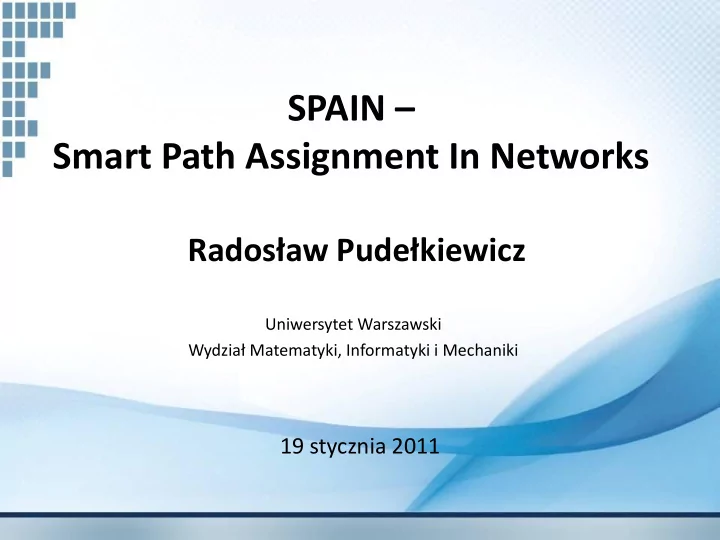

SPAIN – Smart Path Assignment In Networks Radosław Pudełkiewicz Uniwersytet Warszawski Wydział Matematyki, Informatyki i Mechaniki 19 stycznia 2011
SPAIN in single phase SPAIN provides multipath forwarding using inexpensive, commodity off- the-shelf (COTS) Ethernet switches, over arbitrary topologies.
Why Ethernet? Ethernet is the primary network technology for data centers: • Ubiquity • self-configuration • high link bandwidth at low cost
Why Ethernet is hard to scale? Ethernet’s lack of scalability stems from three main problems: • Its use of the Spanning Tree Protocol to automatically ensure a loop-free topology. • Packet floods for learning host locations. • Host-generated broadcasts, especially for ARP.
Currently used solution. „ Adding IP (Layer- 3) routers “solves” the scaling problem via the use of subnets, but introduces new problems, especially the difficulty of supporting dynamic mobility of virtual machines ”
Existing proposals for improving Ethernet scalability
The design of SPAIN SPAIN goals are to: • Deliver more bandwidth and better reliability than spanning tree. • Support arbitrary topologies, not just fat-tree or hypercube, and extract the best bisection bandwidth from any topology. • Utilize unmodified, off-the-shelf, commoditypriced (COTS) Ethernet switches. • Minimize end host software changes, and be incrementally deployable.
Offline configuration of the network in SPAIN These algorithms address several challenges: • Which set of paths to use? • How to map paths to VLANs? • How to handle unplanned topology changes?
Path-set computation
Mapping path sets to VLANs
En example
End-host algorithms An end host uses the following data structures and parameters: • ES(m): the ID of the edge switch to which MAC address m is currently connected. • Vreach(es): the set of VLANs that reach the edge switches. • R: the reachability VLAN map, a bit map encoding the union of Vreach (•) over all es. • Vusable(es): the set of VLANs that have recently tested as usable to reach es. • Trepin is the length of time after which non-TCP flows go through the VLAN re-pinning process. • Tsent is the minimum amount of time since last send on a VLAN that triggers a chirp (see below). • Vsent(es): the set of VLANs that we sent a packet via es within the last Tsent seconds.
Sending a Packet- Selecting a VLAN
Sending a Packet – Periodic VLAN re-selection
Reciving a Packets
Experimental evaluation
End-host overheads
SPAIN vs. spanning tree
Fault tolerance
Incremental deployability
Summary and conclusions „ SPAIN improves aggregate goodput over spanning-tree by 87% on a testbed (…).”
Recommend
More recommend